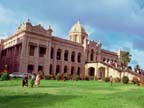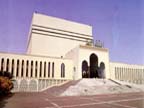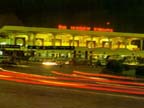|
|
|
|
|
Dhaka The Capital City |
|
Dhaka, the sprawling and bustling national metropolis of Bangladesh, has an exciting history and rich cultural heritage. Founded in 1608, the city alternately enjoyed the glory of the capital of this part when it was successively under the Mughal, the British and Pakistani rules. Intersected by the river Buriganga, Dhaka became the capital of Bangladesh as it emerged as an independent and sovereign state in 1971. Once known as a city of 52 bazars and 53 lanes, Dhaka has a happy blend of Mughal, Victorian and modern architecture as well as a number of historic relics. The recent spurt in high rise buildings is fast changing Dhaka's skyline. The city still has a name for its exotic culinary and cuisine and was once known the world over as a city of mosques and Muslin. |
||||
 |
 |
 |
||
| Ahsan Manzil | Baitul Moqarram - The National Mosque | Zia International Airport, Dhaka | ||
|
Nearby is Sonargaon, the old capital and the throbbing river port of Narayanganj, the main trading point mostly dealing in jute and having a cluster of jute mills. With its commodious national museum, glazing lush green parks and zoo, serpentine lakes, tree line streets, open air bazars and colorful modern shopping plazas gladden with traditional handicrafts and other items, posh and modern luxury hotels, Dhaka provides an exotic beauty of an enchanting oriental capital city. Art and artifacts, theaters, dance, drama and music with their inimitable local touch flourish in Dhaka making it the country's prime cultural center. |
||||
|
Dhaka's major waterfront Sadarghat, crowded with all kinds of rivercrafts, is on the bank of the river Buriganga. Dhaka is also the hub of many industrial, commercial, cultural and political activities. |
||||
| BACK | ||
|
This site is developed and maintained by
Sumit.
Update: 1st February 2002 |